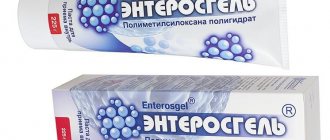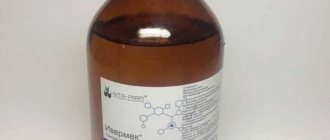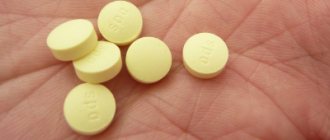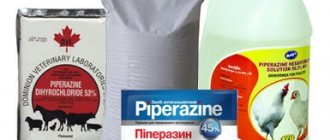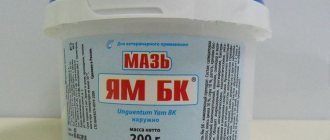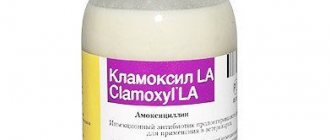Components included in the drug
The drug contains the following compounds:
- In the production of tablets, purified starch is also used, which serves as the main molding component.
- Lactose (milk sugar).
- Gelatin used as a binder.
- Silicon compounds and magnesium stearate.
- The injection form of the drug also contains disodium sulfite and edetate, as well as additionally purified water for injection.
- Sodium chloride (regular table salt).
Metoclopramide hydrochloride monohydrate is the main active compound to which the medicine owes its effect. This substance has a pronounced antiemetic effect. It was originally used medicinally to treat migraines. At the same time, doctors noticed that patients taking this medicine did not vomit at all, even in cases where it should have developed. The essence of the action is to accelerate the removal of food from the stomach to the intestines. Does not cause diarrhea.
Composition of the drug
It is worth paying attention to the components of the drugs; it differs for each of the release forms. The main active ingredient is metoclopramide hydrochloride monohydrate.
The auxiliary components in the tablets are:
- gelatin;
- starch;
- sodium stearate;
- lactose monohydrate;
- silica.
Injection formulations contain the following excipients:
- saline;
- sodium sulfite;
- sodium chloride;
- edetate disodium.
The packaging with the drug contains detailed instructions, but there are no dosages or indications for use in animals.
Storage conditions for the medicine
The drug does not contain particularly “delicate” components, but, nevertheless, when storing it, the following storage conditions must be observed:
- The storage location must be protected from direct sunlight. This is especially important when storing the liquid dosage form of the drug. Ultraviolet radiation has a detrimental effect on the components of the drug.
- When storing the tablet form of the drug, the temperature should be maintained in the range from 0° to 25°C. It is advisable to store the medicine in the form of a solution at a temperature from 0° to 4°C (the ideal place is the top shelves of a household refrigerator). Freezing is extremely undesirable, but the manufacturer reports that after thawing, the product fully retains all its therapeutic properties.
- The medicine is stored so that it is guaranteed that children and pets do not have access to it.
Release forms of Cerucal for dogs
There are two main forms of release of Cerucal: in the form of tablets and solution.
Each of them is convenient in some way. So, the drug in the form of injections acts much faster, but tablets are much more convenient and easier to give.
Injections
Injections can be administered intravenously and intramuscularly. Packaged in dark glass ampoules, equipped with notches for easier opening. Ampoules of five pieces are placed in contour cells, which, in turn, are placed in two pieces in packs made of thick cardboard.
Comparison of release forms
- Cerucal in injections begins to act 3 minutes after intravenous administration and after 10-15 minutes intramuscularly. This method is effective in cases of uncontrollable vomiting, or when taking pills causes rejection by the dog’s body. In liquid form, the dosage of the drug is easier to calculate for small dogs.
- Cerucal in tablets is more convenient to use for preparing an x-ray examination, with a single vomiting and the urge to vomit.
In both forms of release, the duration of administration should not exceed seven days.
Indications for use
There are the following objective indications for the use of Cerucal:
- Manifestations of nausea, cases when the dog feels noticeably sick.
- Directly vomiting.
- The drug may be prescribed for certain intestinal infections.
- The medicine is prescribed for diseases of the stomach accompanied by impaired motility of the latter.
- In addition, the remedy can help with constant belching of unknown etiology.
Important! Cerucal is originally a medical drug, not officially intended for use for veterinary purposes. Therefore, we would categorically not recommend prescribing it yourself!
How does Cerucal work on a dog?
Effect of Cerucal on a dog:
- The drug improves the tone of the muscles of the lower parts of the stomach, including its sphincter, as well as the tone of the muscles of the small intestine.
- The drug reduces the activity of the muscle tissue of the esophagus.
- Due to improved peristalsis of the lower stomach and intestines, the movement of semi-digested food through the gastrointestinal tract is accelerated.
- Normalization of bile secretion. The drug improves the tone and contractility of both the gallbladder itself and the bile ducts of the liver. The product also relieves spasm of the exit sections of the ducts in the lumen of the duodenum.
- The medicine completely stops or significantly reduces the frequency of hiccups.
- The drug helps fight stomach cramps that occur against the background of hyperacid gastritis.
Although the drug is capable of normalizing digestive processes, it does not directly affect the process of synthesis of digestive enzymes and juices. This makes it relatively safe for dogs, but it should still only be prescribed and dosed by a veterinarian!
Cerucal is a very active drug. After administration, it begins to be absorbed into the blood almost immediately. The maximum therapeutic concentration is achieved in just an hour. The medicine is effective for 12 hours . But to achieve maximum effect in the shortest possible time, it is recommended to use a liquid dosage form. Thus, after intramuscular administration of the drug, the effect of the latter begins in just 15 minutes, and after intravenous administration of the drug, the effect occurs within three minutes.
Instructions for use of Cerucal in tablet form
The instructions we have given for the use of Cerucal in tablets are approximate; for each specific case it is necessary to make the necessary amendments.
The drug in the form of tablets is given to pets forcibly by placing the tablet on the root of the tongue and at the same time massaging the dog’s throat (to stimulate the swallowing reflex). You need to not only “knead” the pharynx area, but also move your hand from top to bottom, in the direction from the pharynx to the esophagus. If everything is done correctly, the dog will have to swallow the pill he hates.
Application of "Cerucal" for cats
"Cerucal" in cats is used for profuse vomiting that does not stop spontaneously. With a one-time regurgitation, there is no need for medication. It is considered normal for a cat to shed the fur accumulated in the digestive tract once a month along with vomiting, which she licks off herself.
The drug may be needed for the following diseases, in which vomiting becomes a serious danger to the cat’s life (causes dehydration):
- peptic ulcer of the stomach and intestines;
- reflux esophagitis;
- prolonged hiccups;
- dyskinesia of the bile ducts and inflammation of the gallbladder (vomiting is accompanied by the release of bile);
- helminths;
- poisoning with poor quality products.
As a means of increasing the tone of the intestinal muscles, Cerucal is used for:
- stomach atony;
- intestinal atony;
- loss of muscle contraction in the postoperative period.
Poisoning in a cat
Dosing of the drug for cats
The dosage of the medicine in tablets is carried out according to the proportion: per 1 kg of cat weight - 0.2-0.4 mg of Cerucal. Course duration is 3-5 days. Dosage in ampoules is carried out in a similar way.
Table 2. Indications for use and dosage of “Cerucal” for vomiting in cats.
| Indications for use | Dosage of the drug based on each 1 kg of cat weight |
| Peptic ulcer | 0.2-0.3 mg |
| Intoxication (helminthic infestation, poisoning) | 0.4 mg |
| Bile duct dyskinesia and cholecystitis | 0.3-0.4 mg |
| Reflux – esophagitis | 0.2 mg |
| Hiccups | 0.2 mg |
Instructions for use of "Cerucal" in cats
The medicine is injected subcutaneously at the withers. The skin is pinched and a needle and medication are inserted under it. Intramuscular administration is possible, the needle is inserted into the thigh area to a depth of no more than 1 cm. The maximum number of uses of the drug per day is 3 times. If the daily dose is exceeded, symptoms of overdose develop.
Injection into the cat's withers
How to give a cat an intramuscular injection at home? Why learn to give injections yourself? Advantages and disadvantages of intramuscular injections. We select syringes and needles for injections for cats. How to properly restrain your cat before injection. Injection technique. Possible complications in a cat after the injection. You will learn about this by reading the material on our portal.
Signs of overdose in cats
These symptoms can appear not only when the daily dose of the drug is exceeded (often happens when the dosage of “Cerucal” in tablets is incorrect), but also in case of individual intolerance to the active substance or components of the drug.
Overdose symptoms:
- loss of coordination, dizziness, auditory hallucinations;
- anxiety, desire to be constantly in the arms of the owner, unreasonable fear;
- stool disorders (of any nature);
- hormonal disorders;
- allergies.
Attention! If you are planning a cat pregnancy, then after using the drug you need to skip one hunt (to restore hormonal levels).
Allergy in a cat
Contraindications to the use of Cerucal for cats
If your cat is sick with the following diseases, then it is strictly forbidden to give it “Cerucal”:
- ulcer perforation (rupture);
- CNS diseases: epilepsy, seizures;
- intestinal obstruction;
- oncology;
- individual intolerance to the drug and allergic reactions to its components.
The above diseases can be in a latent form when the owner is unaware of them. The use of "Cerucal" in these cases is detrimental to the animal. For this reason, prior consultation with a specialist is required before administering the drug. In emergency cases, try to call a veterinarian at home and not take independent action.
A sick pet brings a lot of trouble and anxiety to its owners and mistresses. Read our article and find out what diseases cats have and what signs indicate health problems in a cat.
Video - Subcutaneous injection of a cat
How and where to give an injection to a dog
Here’s how to correctly and where to inject a dog using a liquid dosage form:
- The medicine is administered only intramuscularly and intravenously. Subcutaneous injection leads to the development of irritation.
- A good place for intramuscular injection is the gluteal muscle group. The muscle tissue in these places is quite thick and contains many blood vessels. When administered, the medicine is quickly absorbed and distributed evenly throughout the body.
- Intravenous infusions are easiest to do using the saphenous veins running along the inside of the front paw. The skin in such places is thin, the necessary vessels can be easily felt, and therefore it is also not difficult to get into them.
The medicine should be administered carefully and slowly.
Dosage of the drug and signs of overdose
Let us remind you once again: Cerucal is originally a medical medicine, and therefore there are no precisely recommended dosages for veterinary medicine. Therefore, both the dosage of the drug and the signs of overdose were identified by specialists empirically, by trial and error. You need to start with tablets, since they are used most often in veterinary medicine.
And here lies a serious problem. One tablet contains 10 mg of active substance. For every 10 kg of pet weight there should be from 0.3 to 0.5 mg. In short, it is possible to accurately calculate the dose only for a pet weighing at least 40 kg. In this case, there is ¼ tablet per dog.
The injectable form is a different matter. Each 2 ml ampoule contains exactly 10 mg of active ingredient. As in the previous case, for every 10 kg there is 0.3-0.5 mg. Those. For a dog weighing 10 kg, 0.1-0.2 ml of medicine is required. The required dose can be easily measured using an insulin syringe.
The dose must be measured very accurately, since otherwise the dog will almost certainly show the following signs of poisoning:
- The dog's appetite sharply worsens or completely disappears.
- With prolonged overdose, the animal develops exhaustion.
- In the same cases, the dog’s body may stop eating completely.
- In some animals, an overdose leads to the development of profuse diarrhea.
- Anemia may develop.
- Dogs with an overdose of this medicine often become “knocked down” and apathetic.
- When the dose was approximately doubled, the animals showed aggression, severe nervousness, and relapses and exacerbations of all chronic gastrointestinal diseases were possible.
Release form and composition
The main active ingredient of Cerucal is metoclopramide. This medicine acts on special receptors in the brain. There is a small area in the brain that is responsible for vomiting and nausea. Metoclopramide, acting on the receptors of this zone, suppresses vomiting of any origin. The movements of the stomach and intestines are normalized, the nausea goes away.
Cerucal is an anti-vomiting drug that acts on the brain.
The calming effect on the gastrointestinal system of cerucal can be used when conducting research - swallowing a probe or x-raying the stomach.
Cerucal is sold in tablets for oral administration and as a solution for injections. Tablets are small, round, 50 pieces per package. Each tablet contains 10 mg of active ingredient. The ampoules contain a 0.5% solution of metoclopramide in an amount of 2 ml. One box contains 10 ampoules.
Important! Cerucal is a medicine with a strong effect on the central nervous system. Its dosage for vomiting must be calculated by a veterinarian.
Side effects
In case of an overdose or individual sensitivity of the animal’s body (and this happens infrequently), the following side effects are possible:
- Problems with stool. The dog may suffer from both diarrhea and severe, prolonged constipation.
- In some cases, muscle spasms are observed.
- The dog becomes restless and nervous, barking often and for no reason.
- Swelling is possible, especially pronounced in the area of the chest, paws and groin area.
- Hives and other allergic reactions.
- Tachycardia, the dog's pulse increases sharply.
- Increased blood pressure. If the dog already suffers from hypertension, this is extremely dangerous and can lead not only to a serious hypertensive crisis, but also to kidney damage.
If the “side effects” do not appear too clearly, then the drug should be stopped, and after a while the pet’s condition will return to normal. In other situations, the medication is also immediately stopped and a veterinarian is called.
Contraindications
The following contraindications exist:
- The drug should not be given to children under the age of eight months. However, for young animals the use of Cerucal is almost always contraindicated, since calculating the dose can be extremely problematic.
- The medicine is strictly contraindicated in the first half of pregnancy. As a rule, severe toxicosis does not occur in dogs, but it is quite possible, and vomiting is a natural phenomenon that does not harm the health of the pet. But this does not apply to cases of pathologies: if the risk to the mother’s health exceeds the risk to the fetus, taking the drug is allowed under the constant supervision of a veterinarian.
- If vomiting is caused by an exacerbation of some chronic pathologies, the medication is also taken under the constant supervision of a veterinarian.
- The use of the drug while feeding puppies is prohibited. The fact is that the active ingredients of the medicine easily pass into breast milk. Considering the tiny dose of the drug, its concentration can be fatal for newborn puppies.
- Of course, there is no 100% breed predisposition, but the medicine is strongly not recommended for toy terriers due to major problems with dosing.
Contraindications for the use of Cerucal in dogs
The main contraindications for the use of Tsurukal in dogs are:
- puppy age up to 8 months;
- pregnancy and breastfeeding;
- bronchial asthma;
- convulsions;
- liver and kidney pathologies;
- stomach bleeding;
- perforation, kinking or volvulus of the intestine;
- the presence of foreign bodies or neoplasms in the gastrointestinal tract.

